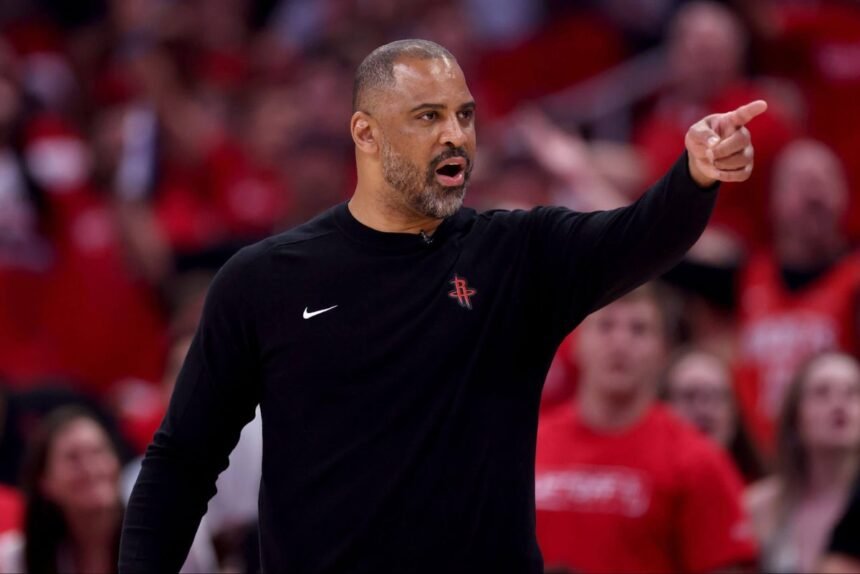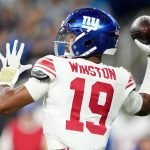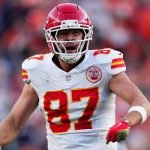Over the past few weeks, Houston Rockets team officials made it clear that building on a 52-win season was the organization’s No. 1 priority, regardless of its postseason embarrassment months before.
Houston’s brass, led by general manager Rafael Stone and owner Patrick Fertitta, aggressively retained its core. Head coach Ime Udoka was signed to a long-term extension, strengthening the alignment that has worked the past two years. Key veteran contributors Fred VanVleet and Steven Adams were next on the docket, their immediate futures hammered out quickly. Important role players — Aaron Holiday, Jeff Green and Jae’Sean Tate — were also re-signed, as was fourth-year forward Jabari Smith Jr., an Udoka favorite.
The trade for 14-time All-Star forward Kevin Durant (which can’t be officially completed until July 6), a blockbuster move that cost the Rockets two starters and NBA Draft capital, was the biggest indicator that Houston intended to contend. During the first few hours of free agency, the organization doubled down on those intentions.
Then, Monday, the Rockets agreed to sign veteran forward Dorian Finney-Smith to a four-year, $53 million deal, according to league sources. Houston also agreed to a deal to reacquire former center Clint Capela, one that will pay the 31-year-old $21.5 million over the next three seasons, a league source said.
Houston isn’t finished doing business, either. The franchise will continue to work on finding third-year, 20-year-old wing Cam Whitmore a new home via trade and look to find a solution for reserve center Jock Landale, either by trade or simply waiving him ahead of his July 7 guarantee date. It also appears that Capela’s addition will need to expand into a sign-and-trade, given Houston’s cap situation.
As it stands, the Rockets are hard-capped at the first apron ($195.9 million) after using the nontaxpayer midlevel exception to sign Finney-Smith.
Reducing Houston’s payroll — by removing Landale’s $8 million non-guaranteed salary — will get it under the apron and afford it more wiggle room. Whitmore’s salary ($3.5 million for 2025-26) isn’t the deciding factor in the Rockets’ flexibility, but it’s apparent his days in Houston were numbered, long before it made any of these offseason moves.
Houston’s sacrifices to pick up 36-year-old Kevin Durant reinforce how much Ime Udoka values productive veterans. (Slaven Vlasic / Getty Images)
Regardless, the common theme in the Rockets’ in-house business or their outward acquisitions is experience. VanVleet, Adams and Capela are 31. Finney-Smith is 32. Durant is 36.
As long as Udoka has been at the helm, his voice within the organization has risen, and the 47-year-old has been vocal about his preference for older veterans. And as such, given the aforementioned alignment with Houston’s front office and ownership, the team has fulfilled his wishes. After Houston’s Game 7 loss to the Golden State Warriors, Udoka’s end-of-season news conference drove home the point about the need for improved IQ and the power of experience, buzzwords that typically precede roster changes.
Make no mistake: The Rockets’ offseason is off to an excellent start. The overarching theme in negotiations has been maintaining financial leverage, all while building a roster that is built for now and later. The two-timeline approach is risky in a vacuum, but context, mainly personnel, is important. It might not have worked out in the Bay with James Wiseman and Jonathan Kuminga, but those are different players from Thompson, Smith, Tari Eason and even Reed Sheppard.
Still, it’s jarring to see Houston move in this manner, particularly because of how quickly its methodology has shifted. Perhaps that’s why it’s difficult to quantify the magnitude of its summer business to this point. For years, the Rockets’ ethos was patience and perseverance, opting to accumulate losses, build through the draft and maintain enough elasticity to capitalize at an opportune moment.
That moment is now. The Rockets have peeled back the curtain on what was once a rebuild, laying out a championship-capable core.
A team that finished in the bottom 10 in half-court offensive efficiency and a myriad of shooting categories has added two veterans who shot better than 40 percent from 3 on good volume, one of whom is already eighth on the NBA’s all-time scoring list. Houston’s coaching staff, which had previously committed to drastic improvement this offseason, will now have several in-game combinations that should yield elite spacing and scoring. Alperen Şengün, coming off an All-Star campaign, will only continue to flourish with better players around him, as will Thompson, who should thrive with quality spacing. And when Houston wants to impose its will on the offensive glass, Adams and Capela are ready to help.
This team, which had already established itself as a top-five defensive unit, added more physicality, rim protection, switchability and point-of-attack aggression. Houston, which has taken pride in its players’ size, can now boast an in-game lineup featuring tremendous length in Thompson, Eason, Finney-Smith, Smith and Durant. The Rockets have the capability of shape-shifting to any opposition and can now play any defensive style they want.
The Rockets, who are determined to win and develop now, should be considered a threat in the Western Conference. Team officials have long used the Oklahoma City Thunder as a loose comparison, but while the differences between the teams are clear, there’s no denying Houston is aware of the league’s parity and is preparing itself for a battle of supremacy over the years to come.
(Top photo of Ime Udoka: Tim Warner / Getty Images)











